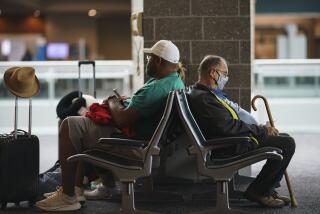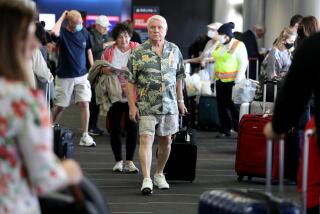Breathing Easier During Travel
- Share via
Lung disease can make some journeys more difficult, especially if supplemental oxygen is used by the traveler. But trips can become less stressful, lung specialists say, if travelers plan ahead, brief their physician on travel plans and consult the airline or cruise ship in advance about policies regarding oxygen transport and use.
Chronic obstructive pulmonary disease (COPD) affects nearly 16 million Americans, according to the American Lung Assn. Defined as blockage of air flow primarily out of the lungs, COPD includes conditions such as emphysema and chronic bronchitis.
Lung disease sufferers who travel should “think about reasonable destinations,” said Dr. Harold M. Silver, pulmonologist and emeritus clinical professor of medicine at George Washington University Medical School in Washington, D.C. For example, Silver said, choose Western Europe, the United States and Canada, since all have excellent medical care systems.
While the need for supplemental oxygen varies from patient to patient, Silver said a traveler who does not need supplemental oxygen at sea level and who can walk several blocks without difficulty will probably be fine without oxygen at altitudes of 5,000 feet or in an airplane flying as high as 35,000 feet.
But lung patients who need oxygen at sea level will probably require even more on an airplane. “In general, oxygen requirements may increase by a third” when aloft, said Dr. Henry Gong, a USC professor of medicine who is chairman of the department of medicine at Rancho Los Amigos Medical Center and a spokesman for the American Lung Assn.
Lung patients should probably contact their physician before a trip, especially if there’s any question about the patient’s ability to cope with altitude changes on an airplane or at a destination. The physician can measure oxygen saturation of the blood and do other evaluations to determine the patient’s status, said Dr. John Dalton, a pulmonologist and director of the respiratory therapy department and pulmonary function laboratory at Santa Monica-UCLA Medical Center.
Travelers who have recently had a pneumothorax (collapsed lung) should not fly, Dalton said. But those who have recently recuperated from pneumonia are probably not at much risk for problems, he said. They may, however, want to ask their doctor if they should pack extra antibiotics to treat any possible relapses, Silver said.
“Take a nonstop, direct flight if possible,” Gong tells all travelers with lung problems. Those needing oxygen should contact vendors at destination cities in advance.
Before booking a trip, call ahead to find out if airlines and cruise ships carry or allow supplemental oxygen to be carried on board.
The law does not require airlines to do so, according to an FAA spokesman. But many, including USAir, Lufthansa, American, Delta, United, America West, British Air and Air New Zealand, do. (A physicians’ advocacy group, the National Assn. for Medical Direction of Respiratory Care, is seeking a regulatory change “so that oxygen will be more readily available,” said Phillip Porte, executive director of the Chevy Chase, Md., organization.) The costs charged for supplementary oxygen vary, with $40 or $50 for a one-way trip or trip segment common.
Also, airlines may require 48-hour advance notice, check-in an hour in advance and a doctor’s statement certifying the need for oxygen.
It’s best to alert the airline at the time reservations are made in order to determine policy, said Air New Zealand spokesman James Boyd. Southwest Airlines, for example, does not allow oxygen for medical reasons on board.
“Any passenger who would require oxygen would not be able to board a Southwest Airlines plane,” said a spokeswoman, citing the costs of training personnel in its use and the expense of the oxygen.
Policies on cruise lines also vary. On Royal Caribbean, for example, passengers can bring their own oxygen or rent from vendors, said a spokeswoman.
On Carnival Cruise Lines, the oxygen on board is reserved for medical emergencies. “Guests who require oxygen day to day are more than welcome to travel with us but they do need to bring their own,” said spokeswoman Jennifer de la Cruz. Before travel, guests must describe the type of oxygen and how it is contained. They must provide a letter from their physician confirming that they are healthy enough to travel.
Once on a plane or ship, lung patients should try to avoid fumes, dust and smoke, Dalton said.
If a lung patient’s destination is at a higher altitude than what he or she is accustomed to, take it easy, Gong said. “Lung patients may be more short of breath with less exercise at altitude.” He advises them to reduce the duration of exercise.
For more information or brochures, call the American Lung Assn., 800-LUNG-USA. For the booklet, “Travel for the Patient With Chronic Obstructive Pulmonary Disease,” by Harold M. Silver, M.D., send $5 to 8029 Herb Farm Drive, Bethesda, MD 20817.
The Healthy Traveler appears the second and fourth week of every month.
More to Read
Sign up for The Wild
We’ll help you find the best places to hike, bike and run, as well as the perfect silent spots for meditation and yoga.
You may occasionally receive promotional content from the Los Angeles Times.






